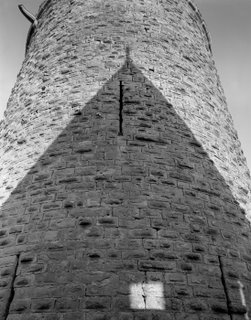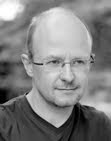
I just returned from an excellent three weeks’ tour - stretching over 5500 km - with the family through Italy, France and Switzerland. We drove from our homeplace to the Riviera Ponente in Ligura, near Savona, where we stayed for a week in a small cottage overlooking the Mediterranean. From there it went to Southwestern France, near Agen, where we spent a week in a country house in the company of fellow photographer Pol Leemans and his wife Greet, and Frans Roex, who runs Axis, a professional photo lab and communication company. Our next destination was another 700 km away, a tiny village in the Vercors where Jo and Dirk, friends of us, just bought a house. We enjoyed the spectacular location and the still very basic amenities of their newly acquired property for a few days and then headed to central Switzerland where we set up our tent for a another week, facing the mighty north faces of the famous “Dreigestirn” Jungfrau-Mönch-Eiger in the Bernese Oberland.
The boot of our car is fairly roomy, so I can take quite a bit of photo gear. This time I left the trusted Rolleiflex in favour of the Canham 4x5, four lenses, a Horseman 6x12 roll film back and 140 sheets of Quickload Acros. Although I know it doesn’t pay to take more than one format, I also packed the M4 with the Noctilux and a IIIf with the 25mm Snapshot Skopar. Predictably, I hardly used them and focused on the 4x5 instead.
This was my first serious foray in large format and I was very curious as how it would go. I really was very diligent and schlepped my Orion Mini Trekker (with the Canham, the lenses, exposure meter, Quickload cassette and sheets, dark cloth – a black T-shirt - and Horseman back) and Gitzo carbon tripod everywhere we went, including up to 7 hour hikes in the mountains. This didn’t really bother me. One just has to think of Vittorio Sella hauling his 7x9 camera through steaming Ruwenzori jungle and up icy Karakoram peaks to realise how lucky one is.
I was happy to have a large stock of Quickload at my disposal so that I never had to worry about having enough film. Exactly a hundred sheets were exposed over the three week trip. Very few of them have been multiple exposures of the same subject. A very good day totalled 15 sheets , whilst on the fairly long, classic hike from Schynige Platte to First over the 2700m high Faulhorn, I set up the camera just once (partly because we were in a hurry to avoid a thunderstorm). I hardly used the pano back (again evidence of how hard it is to mentally switch frames during a campaign).
Although I had some experience manipulating the Canham, setting the camera up almost a hundred times really smoothens the routine. If everything goes well, I need about 10 minutes to go through the whole cycle of setting up the tripod, unpacking the camera, focusing, preparing the cassette, measuring exposure, exposing the sheet and dismantling and packing up. But as it is such an enjoyable activity, I often took more time –up to 20 minutes – to make a picture.
The Canham really delivers what I expected from it. It is a lightweight, compact camera that is easy to set up. Its very long bellows is a real boon. In my experience the camera is rigid enough, even at long bellows extension. However, I am less impressed with the overall mechanics of the camera. After a week a fairly annoying problem developed with the righthand side geared focus rails. The friction has become so high it is painful to manipulate. I will probably send it to Keith Canham in the next couple of weeks for a thorough overhaul.
My collection of 4 lenses – a 90, 150, 305 and 450mm - is perfectly adequate. To my surprise I noticed that I grabbed most often for the 150mm (I’d consider myself more of a wide angle person). Roughly 50% of the pictures were taken with the standard lens. The 300mm was the next most frequently used (25%) and after that comes the 90mm (15%) and the 450mm (10%). So, on the one hand it is interesting to note that the 450 is used only fairly seldom, making the long bellows of the Canham a real luxury. On the other hand, I was really happy to have the possibility to use the long focal length when I did.
Quickload works like a breeze and to my mind the advantages of the system – weight and convenience – justify the extra cost. I hope Fuji will keep stocks of its Quickload emulsions high for a long time to come.
I must say that the whole large format way of working appeals to me. It really feels very comfortable. I didn’t feel restricted in my choice of motives because of the slowness of the approach. Only on a couple of occasions – particularly in the mountains - I was disappointed to miss out on particularly favourable but fleeting atmospheric conditions. The time spent under the dark cloth, framing and focusing, is very enjoyable. One really withdraws from the world for a short while. I have the advantage of being shortsighted, so that I am able to focus without using a loupe. By looking alternately over and through my glasses I can quickly gauge a composition from different distances.
In terms of camera movements, I found that I could do everything I wanted with front rise/fall and tilt. There is nothing particularly mysterious about the whole Scheimpflug principle. Moreover, one can see the impact of movements in real time on the ground glass.
I have a first batch of about 60 sheets back from the lab and it looks like there is a lot of usable material. None of them seem to be out of focus or incorrectly exposed. A few preliminary scans reveal the luscious textures and sharpness one expects from this size of negatives. The picture shown above was taken in an old, very rustic (but stil used) school building in Montpézat, a small village overlooking the Lot valley in Southwestern France (with the Rodenstock Sironar-N 150mm). More to follow!
 In a previous posting I hinted at the fact that I have recently acquired a Noctilux lens for my Leica M. For afficionados, the Noctilux is a fabled object: the most luminous and most expensive lens for the M-series cameras. I have been interested in this lens for a while, but found it difficult to make up my mind. There are relatively few of these lenses around - none of my Leica friends has one - and it is not easy to get an idea of how it performs. The web offers, as usual, a cacophony of mixed opinions on the subject and very few good pictures to judge the merits of this piece of equipment on.
In a previous posting I hinted at the fact that I have recently acquired a Noctilux lens for my Leica M. For afficionados, the Noctilux is a fabled object: the most luminous and most expensive lens for the M-series cameras. I have been interested in this lens for a while, but found it difficult to make up my mind. There are relatively few of these lenses around - none of my Leica friends has one - and it is not easy to get an idea of how it performs. The web offers, as usual, a cacophony of mixed opinions on the subject and very few good pictures to judge the merits of this piece of equipment on. 



